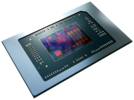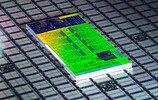AMD Ryzen 7 7840HS vs Intel Core i7-14700HX vs AMD Ryzen 7 7840S
AMD Ryzen 7 7840HS
► remove from comparison
The Ryzen 7 7840HS is a powerful Phoenix family chip that saw the light of day in H1 2023. The processor features 8 cores (16 threads thanks to SMT support) running at 3.8 GHz. The highest Boost clock speed achievable is 5.1 GHz.
Not only does this APU has full might of the Zen 4 architecture at its disposal, it also comes with the new Ryzen AI technology that's set to make generative AI more ubiquitous than ever before. Last but not the least, the Radeon 780M serves as the integrated GPU.
Architecture & Features
Phoenix family chips are powered by the Zen 4 architecture, much like Dragon Range family chips are. The latter however lacks hardware AI workload acceleration capabilities that Phoenix has. Ryzen AI is coming after Intel's DL Boost and GNA technologies; time will tell if this move by AMD is a good idea.
Perhaps more importantly, Zen 4 introduces AVX512 support (which Zen 3 chips did not have) and, thanks to a plethora of other improvements including larger caches/registers/buffers across the board, is set to bring a double-digit IPC improvement.
Elsewhere, the 7840HS has 16 MB of L3 cache and a seriously fast RAM controller (up to LPDDR5x-7500 and up to DDR5-5600, ECC-enabled memory included). PCI-Express speeds are capped at 1.97 GB/s per lane which corresponds to the 4.0 spec.
This Ryzen 7 series chip is designed to run 64-bit Windows 11, 64-bit Windows 10 or Linux; please note that it isn't overclockable and neither is it user-replaceable. It gets soldered down for good instead (FP7, FP7r2, FP8 socket interfaces).
Performance
The average 7840HS in our database is in the same league as the Core i7-12700H, Core i7-12850HX, Core i9-12900H, Core i9-13900H and also the Ryzen 9 7940HS, as far as multi-thread benchmark scores are concerned. This is a very fast chip, as of Q3 2023.
Your mileage may vary depending on how high the CPU power limits are and how competent the cooling solution of your system is.
Graphics
The Radeon 780M (12 CUs / 768 shaders, up to 2,700 MHz) is capable of powering 4 monitors simultaneously with resolutions as high as SUHD 4320p. It will also have little issue hardware-encoding and hardware-decoding the most widely used video codecs (AV1, HEVC, AVC). As far as gaming is concerned, the thing will let you play most games at 1080p as long as you are fine with moderate quality settings. Long story short, this is the best iGPU money can buy, as of H2 2023.
Your mileage may vary depending on how high the CPU power limits are, how competent the cooling solution of your system is, how fast the RAM of your system is (there is no dedicated VRAM here).
Power consumption
This Ryzen 7 series chip has a long-term power limit (default TDP) of 35 W to 54 W, giving system makers a choice between improving battery life and making the system they're designing insanely fast. Either way, an active cooling solution is a must for a laptop or a mini-PC built around this APU.
The 7840HS is built with TSMC's 4 nm process for high, as of late 2023, energy efficiency.
Intel Core i7-14700HX
► remove from comparison
The Intel Core i7-14700HX is a high-end CPU based on the new Raptor Lake architecture for large and heavy notebooks. The CPU was introduced at the beginning of 2024 as part of the Raptor Lake HX refresh. The i7-14700HX is similar to the Core i7-13850HX with slightly higher clocked CPU cores.
The total of 28 threads are divided into P-cores and E-cores, which we already know from Alder Lake. The 14700HX offers 8 performance cores (P-cores) with hyperthreading and 12 efficiency cores (E-cores) without hyperthreading. A total of 28 threads are therefore supported. The P-cores clock at up to 5.5 GHz (single core) and the E-cores up to 3.9 GHz. The integrated memory controller supports a maximum of DDR5 with 5600 MHz.
Compared to Alder Lake, the new Raptor Lake architecture offers improved P-cores (Raptor Cove architecture with more cache), more E-cores (same Gracemont architecture) and higher clock rates thanks to the improved Intel 7 process. Furthermore, Intel now supports faster DDR5 main memory (up to 5600 MHz) in the top models.
The 14700HX is manufactured on the older 10nm FinFET process at Intel (Intel 7 process) and is specified with 55 watts base power and 157 watts turbo power.
AMD Ryzen 7 7840S
► remove from comparison
The AMD Ryzen 7 7840S is a fast high-end laptop processor of the Phoenix series. It offers 8 cores (octa core) based on the Zen 4 architecture that supports hyperthreading (16 threads). The cores clock from 3.8 (base) up to 5.1 GHz (single core boost). The processor includes 8 MB L2 cache and 16 MB L3 cache. The processor is exclusively available in Lenovo laptops but the specs are similar to the regular Ryzen 7 7840HS.
The performance of the R7 7840S is only slightly below the fastest model, the R9 7940HS, as the clock speed difference is only minimal (e.g. -100 MHz / 2% slower single core boost). Therefore, the CPU should also perform slightly higher than the old top model Ryzen 9 6980HX (8 Zen 3 cores with up to 4.9 GHz) at 54W TDP and Ryzen 9 6980HS at 35W TDP. Compared to the higher end Dragon Range series, the 7840HS should be similar to the Ryzen 7 7745HX (also 8 Zen 4 cores, max 5.1 GHz, 55W TDP, 32 MB L3).
The chip integrates a modern and fasts RDNA 3 graphics card (iGPU) called Radeon 780M with 12 CUs and up to 2.7 GHz clock speed. Furthermore, the Phoenix series include a video engine with AV1 de- and encoding, a new Xilinx FPGA based XDNA AI accelerator (Ryzen AI) that should be faster than the AI engine in the Apple M2 SOC and a dual-channel DDR5-5600 / LPDDR5x-7500 memory controller (with ECC support). The connectivity features includes 2 possible USB 4 (40 Gbps) ports and 20 PCIe 4.0 lanes for a GPU and SSDs.
The Phoenix series uses a single monolithic design (unlike the chiplet design of the 7045HX series) and is manufactured in the modern 4nm process at TSMC. The TDP can be configured between 35 and 45 Watt.
| Model | AMD Ryzen 7 7840HS | Intel Core i7-14700HX | AMD Ryzen 7 7840S | ||||||||||||||||||||||||||||||||||||||||||||||||||||||||||||
| Codename | Phoenix-HS (Zen 4) | Raptor Lake-HX Refresh | Phoenix-HS (Zen 4) | ||||||||||||||||||||||||||||||||||||||||||||||||||||||||||||
| Series | AMD Phoenix (Zen 4) | Intel Raptor Lake-HX | AMD Phoenix (Zen 4) | ||||||||||||||||||||||||||||||||||||||||||||||||||||||||||||
| Series: Phoenix (Zen 4) Phoenix-HS (Zen 4) |
|
|
| ||||||||||||||||||||||||||||||||||||||||||||||||||||||||||||
| Clock | 3800 - 5100 MHz | 3900 - 5500 MHz | 3800 - 5100 MHz | ||||||||||||||||||||||||||||||||||||||||||||||||||||||||||||
| L1 Cache | 512 KB | 512 KB | |||||||||||||||||||||||||||||||||||||||||||||||||||||||||||||
| L2 Cache | 8 MB | 24 MB | 8 MB | ||||||||||||||||||||||||||||||||||||||||||||||||||||||||||||
| L3 Cache | 16 MB | 30 MB | 16 MB | ||||||||||||||||||||||||||||||||||||||||||||||||||||||||||||
| Cores / Threads | 8 / 16 | 20 / 28 8 x 5.5 GHz Intel Raptor Cove P-Core 12 x 3.9 GHz Intel Gracemont E-Core | 8 / 16 | ||||||||||||||||||||||||||||||||||||||||||||||||||||||||||||
| TDP | 35 Watt | 55 Watt | 35 Watt | ||||||||||||||||||||||||||||||||||||||||||||||||||||||||||||
| Technology | 4 nm | 10 nm | 4 nm | ||||||||||||||||||||||||||||||||||||||||||||||||||||||||||||
| Die Size | 178 mm2 | 257 mm2 | 178 mm2 | ||||||||||||||||||||||||||||||||||||||||||||||||||||||||||||
| max. Temp. | 100 °C | 100 °C | 100 °C | ||||||||||||||||||||||||||||||||||||||||||||||||||||||||||||
| Socket | FP7/FP7r2/FP8 | BGA1964 | FP7/FP7r2/FP8 | ||||||||||||||||||||||||||||||||||||||||||||||||||||||||||||
| Features | DDR5-5600/LPDDR5x-7500 RAM (incl. ECC), PCIe 4, Ryzen AI, MMX, SSE, SSE2, SSE3, SSSE3, SSE4A, SSE4.1, SSE4.2, AVX, AVX2, AVX-512, BMI2, ABM, FMA, ADX, SMEP, SMAP, SMT, CPB, AES-NI, RDRAND, RDSEED, SHA, SME | DDR4-3200/DDR5-5600 RAM, PCIe 5, Thr. Director, DL Boost, GNA, vPro Enter., MMX, SSE, SSE2, SSE3, SSSE3, SSE4.1, SSE4.2, AVX, AVX2, BMI2, ABM, FMA, ADX, VMX, SMEP, SMAP, EIST, TM1, TM2, HT, Turbo, SST, AES-NI, RDRAND, RDSEED, SHA | DDR5-5600/LPDDR5x-7500 RAM (incl. ECC), PCIe 4, Ryzen AI, MMX, SSE, SSE2, SSE3, SSSE3, SSE4A, SSE4.1, SSE4.2, AVX, AVX2, AVX-512, BMI2, ABM, FMA, ADX, SMEP, SMAP, SMT, CPB, AES-NI, RDRAND, RDSEED, SHA, SME | ||||||||||||||||||||||||||||||||||||||||||||||||||||||||||||
| iGPU | AMD Radeon 780M ( - 2700 MHz) | Intel UHD Graphics 770 ( - 1600 MHz) | AMD Radeon 780M ( - 2700 MHz) | ||||||||||||||||||||||||||||||||||||||||||||||||||||||||||||
| Architecture | x86 | x86 | x86 | ||||||||||||||||||||||||||||||||||||||||||||||||||||||||||||
| Announced | |||||||||||||||||||||||||||||||||||||||||||||||||||||||||||||||
| Manufacturer | www.amd.com | ark.intel.com | www.amd.com | ||||||||||||||||||||||||||||||||||||||||||||||||||||||||||||
| TDP Turbo PL2 | 157 Watt |
Benchmarks
Average Benchmarks AMD Ryzen 7 7840HS → 100% n=40
Average Benchmarks Intel Core i7-14700HX → 125% n=40
Average Benchmarks AMD Ryzen 7 7840S → 96% n=40
* Smaller numbers mean a higher performance
1 This benchmark is not used for the average calculation













